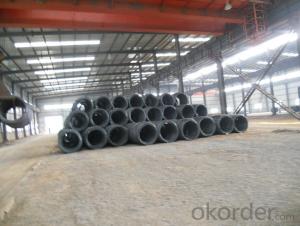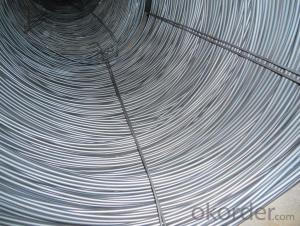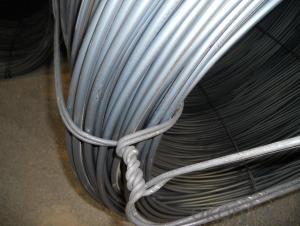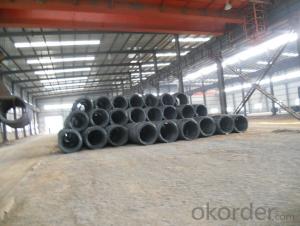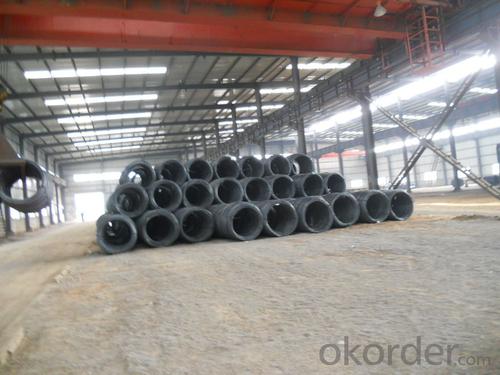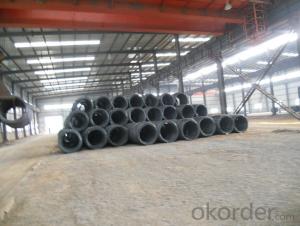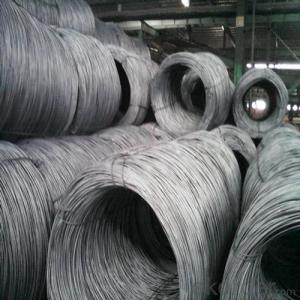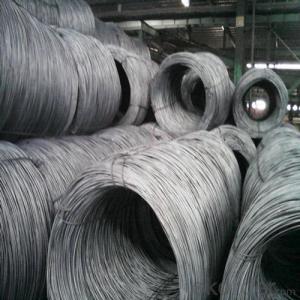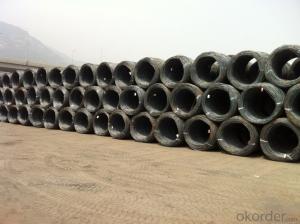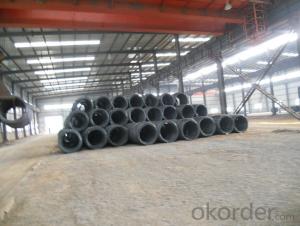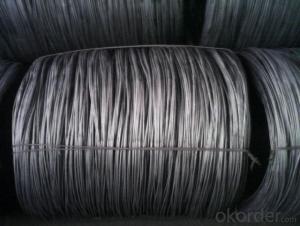Hot Rolled Steel Wire Rode SAE1006~SAE1018,H08A,30MnSi,62B-82B
- Loading Port:
- Tianjin
- Payment Terms:
- TT OR LC
- Min Order Qty:
- 50 m.t.
- Supply Capability:
- 40000 m.t./month
OKorder Service Pledge
OKorder Financial Service
You Might Also Like
Specification
Product Description:
OKorder is offering Hot Rolled Steel Wire Rode SAE1006~SAE1018,H08A,30MnSi,62B-82B at great prices with worldwide shipping. Our supplier is a world-class manufacturer of steel, with our products utilized the world over. OKorder annually supplies products to European, North American and Asian markets. We provide quotations within 24 hours of receiving an inquiry and guarantee competitive prices.
Product Applications:
Hot Rolled Steel Wire Rode SAE1006~SAE1018,H08A,30MnSi,62B-82B are ideal for structural applications and are widely used in the construction of buildings and bridges, and the manufacturing, petrochemical, and transportation industries.
Product Advantages:
OKorder's Hot Rolled Steel Wire Rode SAE1006~SAE1018,H08A,30MnSi,62B-82B are durable, strong, and resist corrosion.
Main Product Features:
· Premium quality
· Prompt delivery & seaworthy packing (30 days after receiving deposit)
· Corrosion resistance
· Can be recycled and reused
· Mill test certification
· Professional Service
· Competitive pricing
Product Specifications:
Steel Grade: Q195 Standard: ASTM, GB
Diameter: 5.5mm, 6.5mm, 7mm,8mm,9mm,10mm,12mm,14mm
6.5mm can be drawing into 2mm/8.0mm can be drawing into 3mm
Type: Drawn Wire in Coil, each coil weight about 2MT
Brand Name: N-RIVER Place of Origin: Hebei, China
Chemical Composition:
Please kindly find our chemistry of our material based on Q195 as below for your information
Trademark | Rank | Chemical composition (quality score) % | |||||
C | Si | Mn | S | P | |||
| ≤ |
| ≤ | ≤ | |||
Q195 |
| 0.06-0.12 | 0.30 | 0.25 | 0.050 | 0.045 | |
Trademark | Rank | Pulling Test | |||||
Bend PointΔs/Mpa | Tensile Strength | Elongation Ratioδ5% | |||||
Thickness (Diameter) /MM | Thickness (Diameter) /MM | ||||||
≤16 | 16-40 | ≤16 | 16-40 | ||||
≥ | ≥ | ||||||
Q195 |
| 195 | 185 | 315-390 | 33 | 32 | |
Usage and Applications of Hot Rolled Wire Rod:
After hot-rolled the products shaped into coil and delivery as finished product, including round, square, rectangular, hexagonal and so on. Since most of the products are round, it is generally called wire rod. Carbon steel wire rod is widely used in construction and manufacturing. Carbon steel wire rod is mainly used for reinforcement of reinforced concrete and welded structure or reprocessed (roberts , nail, etc.) materials, especially used to produce wire drawing, welding electrode, nails, spring, electronic, precise machinery parts and so on.
Packaging & Delivery of Hot Rolled Wire Rod:
Packaging Detail: products are packed in coil, each coil weight around 2 MT, and then shipped by container or bulk vessel
Delivery Detail: within 45 days after received deposit or LC.
Label: to be specified by customer, generally, each bundle has 1-2 labels
Trade terms: FOB, CFR, CIF
FAQ:
Q1: Why buy Materials & Equipment from OKorder.com?
A1: All products offered byOKorder.com are carefully selected from China's most reliable manufacturing enterprises. Through its ISO certifications, OKorder.com adheres to the highest standards and a commitment to supply chain safety and customer satisfaction.
Q2: How do we guarantee the quality of our products?
A2: We have established an advanced quality management system which conducts strict quality tests at every step, from raw materials to the final product. At the same time, we provide extensive follow-up service assurances as required.
Q3: How soon can we receive the product after purchase?
A3: Within three days of placing an order, we will begin production. The specific shipping date is dependent upon international and government factors, but is typically 7 to 10 workdays.
Q4: What makes stainless steel stainless?
A4: Stainless steel must contain at least 10.5 % chromium. It is this element that reacts with the oxygen in the air to form a complex chrome-oxide surface layer that is invisible but strong enough to prevent further oxygen from "staining" (rusting) the surface. Higher levels of chromium and the addition of other alloying elements such as nickel and molybdenum enhance this surface layer and improve the corrosion resistance of the stainless material.
Q5: Can stainless steel rust?
A5: Stainless does not "rust" as you think of regular steel rusting with a red oxide on the surface that flakes off. If you see red rust it is probably due to some iron particles that have contaminated the surface of the stainless steel and it is these iron particles that are rusting. Look at the source of the rusting and see if you can remove it from the surface.
Images:

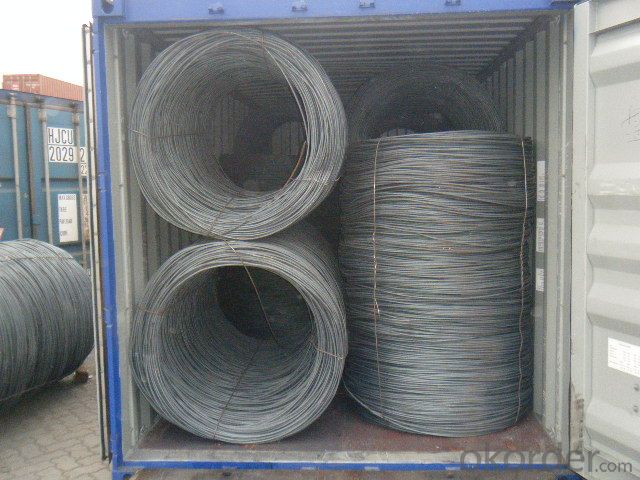
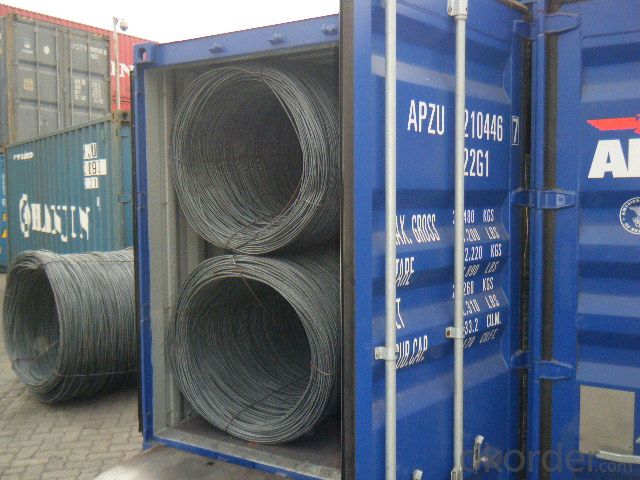
- Q: How is steel wire rod protected from rust and corrosion during storage?
- Steel wire rod is protected from rust and corrosion during storage by applying a coating or a layer of protective oil on its surface. This prevents moisture and oxygen from coming into contact with the steel, which helps to minimize the risk of rust and corrosion. Additionally, proper storage conditions, such as keeping the wire rod in a dry and well-ventilated area, also play a crucial role in protecting it from rust and corrosion.
- Q: How are steel wire rods used in the production of wire springs?
- Steel wire rods are an essential component in the production of wire springs. These rods are first melted and then shaped into a cylindrical form through the process of rolling. The resulting steel wire rods are then drawn through a series of dies to reduce their diameter and increase their length. This drawing process also imparts strength and flexibility to the wire rods, making them suitable for use in springs. Once the steel wire rods have been drawn, they are typically coiled onto large spools or reels. This coiled wire is then fed into spring-making machines, where it is further processed to form wire springs. The wire is cut to the desired length and then fed into a machine that shapes it into the desired spring form, such as a helical coil or a conical shape. The inherent strength and elasticity of the steel wire rods make them ideal for use in wire springs. These springs are used in a wide range of applications, such as automotive suspensions, furniture, industrial machinery, and even household appliances. The steel wire rods provide the necessary tensile strength and resilience to withstand the forces and stresses that springs are subjected to in these applications. In summary, steel wire rods play a vital role in the production of wire springs. They provide the necessary strength, flexibility, and resilience required for these springs to function effectively in various industries and applications.
- Q: What are the common industry best practices for steel wire rod manufacturers?
- Some common industry best practices for steel wire rod manufacturers include maintaining strict quality control measures to ensure consistent product quality, adhering to international standards and certifications, implementing efficient and environmentally friendly production processes, investing in advanced technology and equipment to enhance productivity and reduce waste, prioritizing worker safety and continuous training, fostering collaborative relationships with suppliers and customers, and staying updated with market trends and customer demands to remain competitive in the industry.
- Q: What are the potential applications of stainless steel wire rod?
- Stainless steel wire rod has a wide range of potential applications due to its strength, durability, and corrosion resistance. It can be used in the construction industry for reinforcing concrete structures, in the automotive industry for manufacturing various components, in the medical field for surgical instruments, and in the aerospace sector for aircraft manufacturing. Additionally, it is commonly utilized in the production of kitchenware, electrical appliances, and various industrial equipment.
- Q: What are the main components of steel wire rod?
- The main components of steel wire rod are iron, carbon, and other alloying elements such as manganese, silicon, and chromium.
- Q: What are the different types of wire mesh for filtration made from steel wire rod?
- Wire mesh for filtration, which is made from steel wire rod, comes in various types. These include: 1. The most common and basic type is plain weave mesh. It is created by weaving the steel wire rod in a simple over-and-under pattern, resulting in a robust and sturdy mesh. Plain weave mesh is suitable for general filtration purposes. 2. Twilled weave mesh is characterized by a diagonal pattern formed by the weave. It has a higher mesh count compared to plain weave, enabling finer filtration. Twilled weave mesh is often employed in applications that require a higher level of filtration. 3. Dutch weave mesh is made by using two different wire diameters for the warp and weft wires. The warp wires are thicker, while the weft wires are thinner. This produces a tightly woven mesh with smaller openings in the weft direction, making it ideal for fine filtration applications. 4. Welded mesh is created by welding the intersecting points of the steel wire rod, resulting in a strong and durable mesh structure. It is commonly used in industrial filtration applications that require high strength and rigidity. 5. Expanded metal mesh is produced by stretching and expanding a sheet of steel wire rod, creating diamond-shaped openings. This type of mesh offers excellent strength and rigidity, making it suitable for heavy-duty filtration applications. Each type of wire mesh has unique filtration capabilities and is suitable for specific applications. The choice of wire mesh for filtration made from steel wire rod depends on factors such as the desired filtration level, strength requirements, and the specific environment in which it will be utilized.
- Q: How is steel wire rod used in the manufacturing of wire rope pulleys?
- Steel wire rod is used in the manufacturing of wire rope pulleys as the primary material for the pulley's core construction. The steel wire rod is carefully formed and shaped to create the framework of the pulley, providing strength, durability, and flexibility required for its functioning. The wire rod's high tensile strength and resistance to wear and tear make it ideal for handling heavy loads and enduring rigorous usage in various applications that require wire rope pulleys.
- Q: What are the different types of steel wire rod rolling processes?
- There are several different types of steel wire rod rolling processes, including hot rolling, cold rolling, and warm rolling. Each process has its own advantages and is used for specific applications. Hot rolling involves heating the steel rod and then passing it through a series of rollers to reduce its diameter and increase its length. Cold rolling, on the other hand, is performed at room temperature and results in a smoother finish and increased strength. Warm rolling is a combination of hot and cold rolling, where the steel rod is heated to a lower temperature than in hot rolling but higher than in cold rolling. This process offers a balance between strength and surface quality.
- Q: What are the different types of steel wire rod surface defect prevention and control measures?
- There are various types of steel wire rod surface defect prevention and control measures, including proper handling and storage of wire rods to prevent corrosion, regular inspection and maintenance of equipment to avoid surface damage during production processes, implementing effective cooling techniques to prevent thermal cracks or deformations, and employing quality control measures such as rigorous testing and sorting to remove defective wire rods. Additionally, using appropriate lubricants during wire drawing processes and implementing surface treatment methods like pickling or coating can also help prevent surface defects in steel wire rods.
- Q: How is steel wire rod used in the manufacturing of wire forms for display racks?
- Steel wire rod is used in the manufacturing of wire forms for display racks as it serves as the primary raw material. The rod is first heated and then drawn through a series of dies to reduce its diameter, resulting in a long, thin wire. This wire is then further processed and manipulated to create various wire forms, such as hooks, shelves, and grids, which are used to construct the display racks. The strength and durability of steel wire rod make it an ideal choice for supporting and displaying various products in retail environments.
Send your message to us
Hot Rolled Steel Wire Rode SAE1006~SAE1018,H08A,30MnSi,62B-82B
- Loading Port:
- Tianjin
- Payment Terms:
- TT OR LC
- Min Order Qty:
- 50 m.t.
- Supply Capability:
- 40000 m.t./month
OKorder Service Pledge
OKorder Financial Service
Similar products
Hot products
Hot Searches
Related keywords
